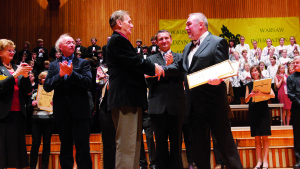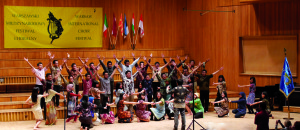Every year at the end of October, the International Warsaw Choir Festival, “Varsovia Cantat” (www.varsoviacantat.pl), takes place. I am lucky to have been a jury member of this event for many years and, last October, I was pleased to be a part of the tenth iteration of the festival that brings top a cappella choirs to the capital of Poland. It was a great occasion to reflect, together with my colleagues, on the last ten years. All of them are very active jury members and shared their opinion with me, basing their discussions not only on their experience in Warsaw of course, but on many other festivals and choral events they have attended. The jury panel consisted of Prof. Romuald Twardowski (Polish composer), Bernard Gfrerer (Salzburg, Austria), Agnes Gerenday (Budapest, Hungary) and Carmen Moreno (Barcelona, Spain).
Changes in attitudes towards competition singing and concerts
The main component of the “Varsovia Cantat” festival is competition singing. Ten years ago, choirs were of course interested in winning the prizes, but for many the main goal was to take part in as many additional concerts as possible. In the earlier years, with an average of eighteen to twenty-five choirs, the organisers had difficulty squeezing them into ten or twelve joint concerts. In recent years, with almost thirty choirs each time, they needed to provide for just four or five joint concerts. This obviously means that now choirs are more focused on competing than performing in general. Moreover, ten years ago during the additional joint concerts, choirs wanted to sing for as long as possible – often twenty-five to thirty minutes was not long enough for them. Nowadays, some choirs have difficulty singing a twenty-minute programme and quite often just repeat their competition programme. Why is that? Do they lack confidence? All the choirs selected for “Varsovia Cantat” are good or very good ensembles, which at one time or another have won top prizes at many choral festivals around the world. So, from my point of view, for many choirs becoming a champion is more important than performing to an audience. Because of this, the level of performance has been steadily increasing, but is singing in a choir only about winning points?

Changes in repertoire
As with the length of the additional concert programme, many years ago choirs tried to maximise competition time and chose as long a programme as possible; in many cases, this resulted in going into overtime quite significantly, which, as can be expected, did not make the jury happy. In my opinion, it is quite easy to measure the time of a performance based on rehearsals. Naturally, you may miscalculate by one or two minutes, but why did some choirs exceed performance times by five or more minutes? Now, this does not happen often and we even have cases of choirs worrying whether their repertoire is too short!
We noticed a slight tendency towards choirs singing more contemporary music, both international and originating from their own country, and more 15th or 16th century music, naturally including many performances of the “forever live” music of Giovanni Pierluigi da Palestrina. There has been a slight decline in performances of 18th-19th century music. Since the first festival, choirs from the former eastern bloc have had a tendency to sing quite a lot of spiritual songs or “entertaining music”; they were perfectly prepared vocally, however they had some style-interpretation problems, which, after a few years, almost disappeared. Later on, they started to use more and more songs from their own countries and, surprisingly, choirs from the north and west started to perform more and more “eastern” music, including pieces originating from the Orthodox Church. Many choirs fully understood that some compositions, although beautiful and quite famous, are not particularly suitable for the festival, as they are more appropriate for concerts. Choirs understood that selecting the repertoire is very important and should show the variety of vocal skills within the choir. Earlier choirs often sang repertoires which they had known for many years, but in many cases that was the wrong approach, as they felt too confident with their old repertoire and, consequently, they did not put in much effort during the preparation period. There was no new repertoire for the competition to refresh choristers’ brains. No challenges, no results!

Changes in the type of choir
As is commonly known, most choirs that performed at “Varsovia Cantat” were mixed choirs. Ten years ago, it was common to see a choir with forty-five to fifty or more singers. In recent years, there has been a decrease in the average number of choristers and a preference for more chamber forms. The dominating type of mixed choir in terms of high-level performance is still the university choir. More often than not, these choirs consist not only of students but also of graduates and university lecturers. Surprisingly, male and female choirs, which, year by year, have become increasingly rare, have returned to glory in recent years and started to appear more often in the competition. The average children’s choir age has risen – now fourteen to fifteen years, where earlier it was eleven to thirteen years. In some cases, it is difficult to call them children’s choirs; they should be named “youth choirs”. The young children’s choirs, with choristers aged seven to twelve years, have seldom performed recently.
Changes in the social life of the choir
During the festival, all choirs are accompanied by a local choir member or volunteer to help them move around a relatively big city such as Warsaw. After each festival, I also meet these people and we try to summarise the festival. Compared to the early festivals, when choirs enjoyed their free time so much that they barely made it for the competition singing or additional concerts, spending most of their time in the city, nowadays, more choirs spend their time rehearsing at the hotel. This is quite understandable, but curiously this happens even after the competition or additional concerts. Of course, they spend time together besides singing, but more often they split into small groups, rather than staying together as a whole choir. In some cases, the only choir photo they bring back from Warsaw is from the concert hall. Are singers becoming less sociable? Or is it just a general tendency around the world?
How audiences have changed
The audience, which is very important for the choir during the concert, does not always help during the competition. Audiences have become lazier with respect to those in the past. There are more and more people at the gala concert, as it is easier to come for two hours and listen to the best of the whole festival than it is to spend ten hours listening to competition singing – but this would be the place where they could listen to some new or lesser known compositions. The gala choirs of course choose very good repertoires, but usually they are pieces well known to choral lovers. Audiences at the evening concerts are as unpredictable as the weather, and in fact the weather is unfortunately the most important factor. In relatively warm weather, we have crowds at the concerts, but if it is raining or cold, fewer people come. Ten years ago, the weather was not so important for the audience. Can we blame climate change?
I’m glad that, over the past ten years, almost 250 choirs from around the world have come to “Varsovia Cantat”, and the festival has remained loyal to its a cappella profile, which for me is the best type of choral performance – it is maybe not as spectacular as famous works with an orchestra, but it is the most demanding and beautiful at the same time.


